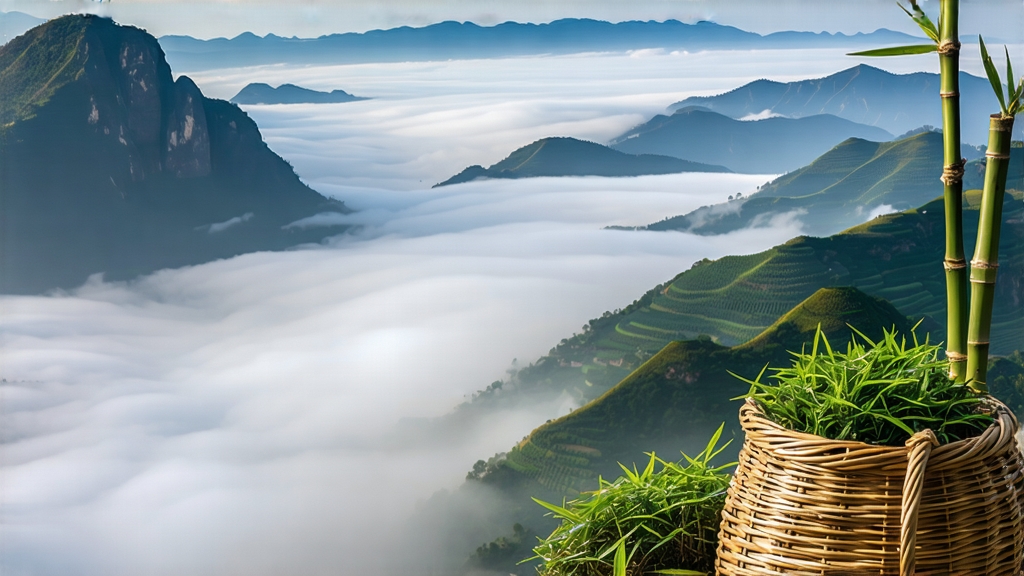
Tucked high above the Sichuan basin, where the first light of dawn spills across cloud-veiled ridges, Meng Ding Huang Ya has been quietly shaping the soul of yellow tea for twelve centuries. International drinkers often meet yellow tea as a curiosity—neither green freshness nor black depth—yet this bud-only treasure from Meng Ding Shan reveals the genre’s most poetic expression. To understand it is to witness a micro-fermentation so gentle it feels like breathing, a craft once reserved for Tang dynasty emperors and still guarded by a handful of hereditary tea masters.
History: from palace secret to mountain heirloom
Meng Ding Shan, “the misty peak,” rises 1 450 m at the western edge of the Sichuan red-basin. Buddhist monks began planting tea during the Han dynasty; by Tang (618-907 CE) the region’s tiny spring buds were steamed, pressed into cakes, and dispatched to Chang-an as tribute. When cake tea fell from fashion in Song times, local monks experimented with “men huang”—sealed yellowing—to stabilise the green colour while adding a mellow sweetness. The technique spread slowly, but Meng Ding remained its spiritual home. Qing emperors renewed the tribute status in 1725, giving the tea its imperial nickname “Gold of the West.” After 1949 the gardens were collectivised; today 300 hectares of state-protected terraces supply fewer than 15 tonnes of authentic Huang Ya each year, 70 % of which never leaves China.
Micro-terroir: why the mountain itself is an ingredient
The peak sits at the meeting point of Tibetan cold air and Sichuan humidity. Night temperatures can drop 15 °C below daytime highs, forcing the plant to store amino acids in tight buds. Permafog filters UV light, increasing chlorophyll while suppressing bitter catechins. Soils are young granite mixed with ancient tea-leaf compost; drainage is so sharp that roots dive two metres, mining minerals that translate into a cooling, almost metallic finish. Only three clones—Meng Ding #9, #16 and the heirloom “xiao ye zhong”—are permitted; each bush is kept below 80 cm so that every pluck remains a single terminal bud with one just-unfurling leaf, no longer than 2.5 cm.
Craft: the 48-hour “breath” that creates yellow
Harvest opens on the first day the mountain fog lifts before 09:00, usually 20 March to 5 April. Pickers wear cotton gloves to avoid hand-oil on the downy tips; leaf is dropped into bamboo baskets lined with fresh banana leaves to prevent compression bruises. Within two hours the buds arrive at the tiny cliff-side workshop where three consecutive firings alternate with sealed yellowing—the step that distinguishes yellow from green tea.
- Sha Qing (kill-green) at 140 °C on a sloping bamboo-fired wok lasts 180 seconds; the master’s palm, calloused but sensitive, flips the leaf in a figure-eight rhythm that feels more like caressing than stirring. Enzymes are halted yet moisture remains above 62 %.
- Men Huang (sealed yellowing) begins while the leaf is still spine-warm. It is wrapped in two layers: inner yellow cotton cloth, outer kraft paper, then stacked in cedar boxes. Every 30 minutes the parcels are opened, the leaf gently shaken to redistribute heat, then resealed. Over 6–8 hours chlorophyll gently oxidises, turning the bud tip a pale primrose while amino acids convert into soluble sugars.
- Hong Bei (low-temperature baking) follows at 60 °C for 20 minutes to fix the colour and reduce moisture to 20 %.
- A second men huang, cooler and longer (12 °C, 70 % RH, 12 h), deepens the yellow and develops the hallmark “chestnut over orchid” aroma.
- Final足火 (full firing) at 50 °C brings water content to 5 %. The finished tea looks like tiny golden fish-hooks, each bud tipped with a faint downy halo; liquor colour is apricot with a jade-green rim under white light.
Grades & nomenclature
Imperial Tip (特级黄芽): 100 % single buds, harvested before Qingming, 1 kg needs 42 000 plucks.
Fine Bud (一级黄小芽): bud plus half-open leaf, picked before 5 April.
Mountain Rain (二级黄大芽):